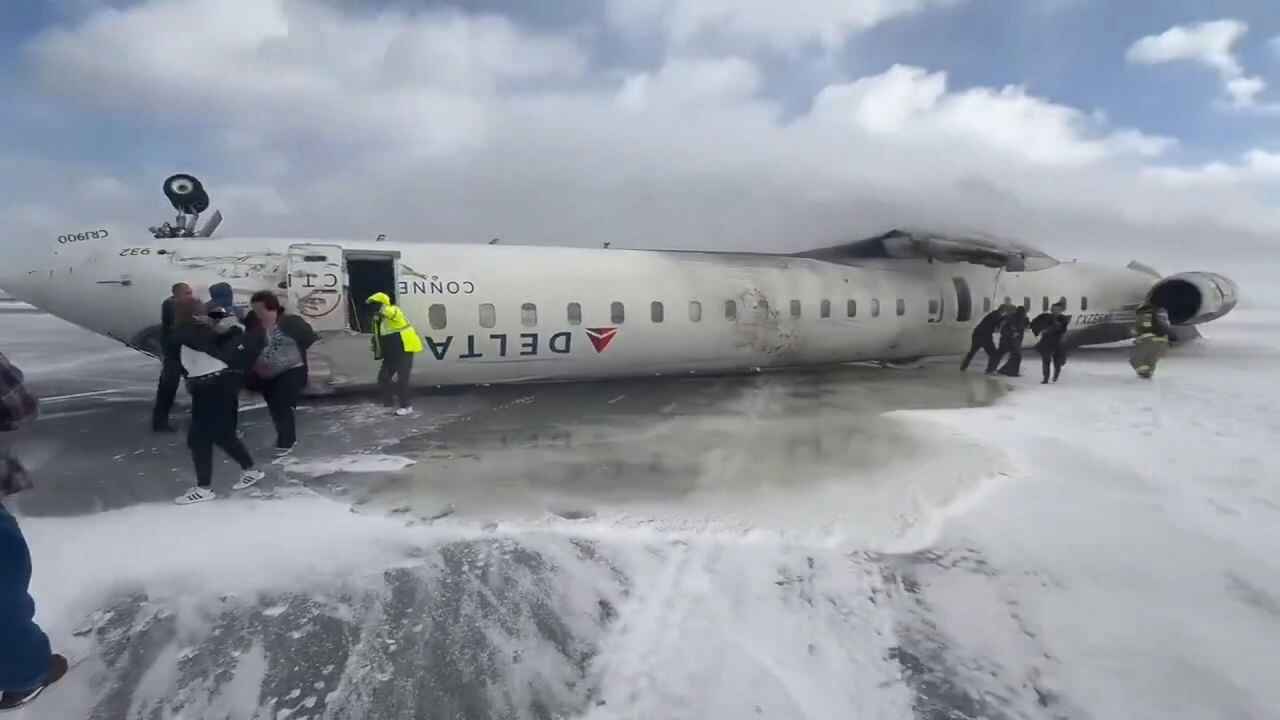Toronto Plane Crash : Causes, Investigation, and Impact
Introduction
The Toronto plane crash involving Delta Connection Flight 4819 has left the world in shock, raising concerns about aviation safety, runway conditions, and weather-related risks. The incident, which occurred on February 17, 2025, at Toronto Pearson International Airport, involved a Bombardier CRJ900 aircraft that flipped upside down upon landing, leaving 18 people injured. Fortunately, no fatalities were reported.
In this comprehensive report, we will analyze the details of the crash, contributing factors, official investigations, and its impact on the aviation industry.
Details of the Crash
Timeline of Events
- Flight Route: The aircraft was traveling from Minneapolis-Saint Paul International Airport (MSP) to Toronto Pearson International Airport (YYZ).
- Landing Time: The plane attempted to land at approximately 2:30 PM local time.
- Crash Incident: Witnesses report that the aircraft landed forcefully, skidded on the runway, and eventually flipped upside down.
- Immediate Aftermath: A fire broke out on one side of the aircraft, but all passengers and crew were safely evacuated.
- Injuries Reported: 18 people sustained injuries, though none were life-threatening.
Passenger Accounts
Survivors described the landing as extremely rough. John Nelson, a passenger aboard the flight, stated:
“The plane hit the ground super hard, skidded sideways, and before we knew it, we were upside down. There was fire on one side, and the smell of fuel was intense.”
Such firsthand accounts provide crucial insight into the severity of the impact and the urgency of the rescue efforts.
Causes of the Crash
While official investigations are still underway, several potential causes have been identified:
1. Weather Conditions
Although weather reports indicated clear skies at the time of landing, the runway was covered in snow. This could have led to reduced friction, making it difficult for the aircraft to slow down effectively.
Additionally, gusty winds were recorded, which may have contributed to instability upon landing.
2. Runway Conditions
Toronto Pearson International Airport had recently experienced heavy snowfall, leading to icy patches on the runway. Poor braking conditions can increase the risk of skidding, which may have played a significant role in the accident.
3. Pilot Error
Human error remains a possibility. If the pilot miscalculated the approach speed or applied incorrect landing techniques, the forceful impact could have contributed to the plane losing control.
4. Mechanical Failure
Investigators are also considering whether any mechanical issues—such as landing gear failure, brake malfunctions, or thrust reverser problems—may have contributed to the incident.
5. Air Traffic Control (ATC) Instructions
ATC decisions, such as runway assignments or clearance times, could have affected the landing conditions. Investigators will review communication logs between the pilots and ATC for any potential misjudgments.
Investigation and Response
Emergency Response
- Firefighters and medical personnel arrived on the scene within minutes.
- Passengers were evacuated via emergency slides and exits before the fire spread.
- Injured passengers were transported to local hospitals, and authorities confirmed that none were in critical condition.
Ongoing Investigation
The Transportation Safety Board of Canada (TSB) is leading the investigation, working alongside:
- U.S. National Transportation Safety Board (NTSB)
- Federal Aviation Administration (FAA)
- Delta Air Lines’ internal safety team
Investigators are focusing on:
- Flight data recorder (FDR) and cockpit voice recorder (CVR) analysis
- Aircraft maintenance records
- Runway inspection reports
- Pilot training and experience
Implications for Aviation Safety
Runway Safety Improvements
This incident highlights the importance of better runway maintenance, especially in winter conditions. Airports may need to:
- Improve de-icing procedures
- Enhance runway traction control systems
- Deploy real-time weather monitoring systems
Pilot Training Enhancements
The crash raises questions about whether pilots should receive additional training on:
- Landing techniques in icy conditions
- Handling turbulent approaches
- Emergency response protocols
Aircraft Safety Inspections
Authorities may tighten aircraft inspection protocols, ensuring that landing gear, brakes, and thrust reversers undergo more frequent safety checks.
Economic and Industry Impact
Airline Reputations
Aviation accidents significantly impact public trust. Delta Air Lines may face:
- Reputation damage
- Increased safety scrutiny
- Financial compensation claims from injured passengers
Flight Disruptions
Following the crash, Toronto Pearson International Airport temporarily shut down operations, affecting:
- Flight schedules and delays
- Passenger inconvenience
- Potential revenue loss for the airline and airport
Insurance and Liability Costs
Delta Air Lines and its insurance providers may face:
- Legal claims from passengers
- Compensation payouts
- Higher insurance premiums moving forward
Lessons Learned
Enhanced Communication Between Pilots and ATC
Stronger coordination between air traffic controllers and flight crews could help prevent misjudged landings in adverse conditions.
Upgraded Runway Surveillance
Using advanced sensors to monitor runway conditions in real-time could improve decision-making for safe landings.
Improved Aircraft Design
Future aircraft models may incorporate better stability control mechanisms to reduce crash risks in harsh landing conditions.
Conclusion
The Toronto plane crash serves as a wake-up call for the aviation industry, emphasizing the importance of safety protocols, pilot training, and runway maintenance. As investigations unfold, lessons learned from this incident will shape future air travel safety measures, ultimately making the skies safer for everyone.






